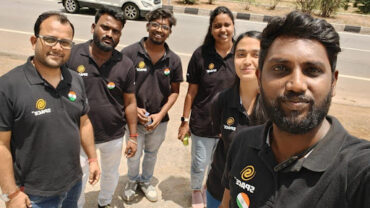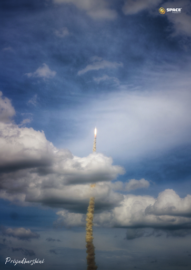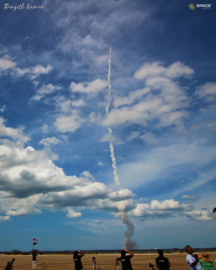As the sun shone high in the sky, clouds of people zoomed in to witness the historic moment of the Indian Space Research Organisation(ISRO). On 14th of July 2023 at 2:35 PM IST, the Launch Vehicle Mark III, flew up, up, and away to the Earth’s Moon, Luna. The spacecraft blasted off the Satish Dhawan Space Centre in Sriharikota and underwent the necessary Geostationary Transfer Orbit maneuvers.
Chandrayaan 3, is the third lunar exploration mission by ISRO. It is the successor to Chandrayaan 2, which was launched in July 2019. Chandrayaan 2 consisted of an orbiter, a lander called Vikram, and a rover called Pragyan. Unfortunately, the lander lost communication with the mission control during its descent, and the rover was not deployed on the lunar surface as planned.


About Chandrayaan 3
‘Fall seven times, rise up eight!’ Such was the motto of ISRO when it launched the Chandrayaan-3. Following the partial success of Chandrayaan-2, ISRO announced plans for Chandrayaan-3 to complete the mission’s objectives of landing a rover on the lunar surface. The primary goal of Chandrayaan 3 is to demonstrate India’s capability to soft-land on the Moon and operate a rover on its surface. The mission aims to further expand our understanding of the Moon’s geology, mineralogy, and evolution.
Thousands of people gathered at Pulicat Lake to watch the beast roaring up in the sky. Among them was the SPACE Chennai Team, who were ready to seize the moment with the cameras and telescopes. The team went live both on Youtube and Instagram, where people from around the world joined us and observed the launch virtually. As the countdown began, the fidgeting of fingers stopped and all were ready to freeze the moment using the DSLRs and mobile phone cameras.
A deafening experience!
The laws of physics were once again proved as the roar of the rocket was heard only after a few seconds, and by then the rocket was making its way through the snowy clouds. After a few clicks, I was awestruck by the scenic beauty of the rocket, which left a trail as it was getting an inch closer to its destination. It took me a fraction of a second to realize the significance of the moment and get back to capturing it.
As the rocket fired up, the sound of it was heard kilometers away from the launch. But, The applause of every Indian witnessing the event surpassed the roar of the rocket. The glistening eyes of the people met the curve of their lips and hands were extended to congratulate each other. I was lucky to capture the majestic view of the rocket using the 18- 55mm DSLR and processed the image using Snapseed. The picture was submitted to NASA’s Astronomy Picture of the Day (APOD) and was selected to be published on July 19th, 2023 on the official APOD page. Below is the APOD picture along with other captures of the day!
About the Mission:

While the SPACE Chennai team handled the on-field queries, the Delhi educators took part in the media discussion and gave interviews to various TV channels including Times New, Mirror Now, ABP News, etc. They explained the mission in detail so even a layman could understand the mission thoroughly.
The mission’s objectives are:
- Getting a lander safe and soft landing on the surface of the Moon.
- Observing and demonstrating the rover’s loitering capabilities on the Moon.
- In-site scientific observation makes scientific experiments on the chemical and natural elements, soil, water, etc. available on the surface of the Moon to better understand and practice the composition of the Moon.
It will place Chandrayaan 3 into an approximately 170 x 36,500 km elliptic parking orbit. The propulsion module will bring the lander/rover into a 100 km circular polar lunar orbit and separate. The lander will then touch down with the rover in the south polar region of the Moon, near 69.37 S, 32.35 E. Touchdown velocity is planned to be less than 2 m/s vertical and 0.5 m/s horizontal. The propulsion module/communications relay satellite will remain in lunar orbit to enable communications with Earth. Chandrayaan 2 will also be used as a backup relay. The lander and rover are designed to operate for one lunar daylight period (about 14 Earth days).




PAYLOADS:
Chandrayaan 3 comprises a Propulsion Module (PM), 1752kg Lander Module (LM), and 26kg Rover. In total, all the components weigh 3900 kg. The mission will not carry an orbiter (unlike Chandrayaan 2). The PM will serve as the communications relay satellite and use Chandrayaan-2’s orbiter for backup. The PM will be responsible for transporting the LM to 100km in lunar orbit.
The PM will have one payload – Q-polarimetry of Habitable Planet Earth (SHAPE) to study the spectral and Polarimetric measurements of Earth from the lunar orbit. SHAPE will collect data based on the polarization of light reflected by Earth which will be used to look for exoplanets that exhibit similar characteristics.
The LM will have four payloads:
- Chandra’s Surface Thermophysical experiment (ChaSTE) to measure thermal conductivity and temperature.
- Instrument for Lunar Seismic Activity (ILSA) for measuring the seismicity around the landing site.
- Langmuir Probe (LP) will measure the density of plasma (ions and electrons) near the lunar surface and how it changes with time.
- The fourth load will be of NASA, called the LASER Retroreflector Array (LRA) to shed light on the dynamics of the Moon system.
The rover will have two payloads:
- Alpha particle x-ray spectrometer (APXS) can help determine the elemental composition of the lunar rocks and soil at the landing site.
- Laser Included Breakdown Spectroscope (LIBS) for deriving the elemental composition in the vicinity of the landing state and can provide a qualitative and quantitative elemental analysis of the lunar surface and estimate the chemical composition.
TECHNOLOGICAL ADVANCEMENTS:
Chandrayaan-3 builds upon the technological advancements of Chandrayaan-2 to enhance mission capabilities. The lander and rover systems have undergone significant upgrades to improve performance and reliability, increasing the chances of a successful landing.
COST:
Confirming the existence of the project, ISRO’s former chairman K. Sivan stated that the cost would be around ₹615 crore, which is less than the budget of some high-production movies (such as ‘Adipurush’, the budget of around ₹700 crores).
INTERNATIONAL COLLABORATIONS:
Chandrayaan-3 involves collaborative efforts with international space agencies and organizations. Discussions are underway for data sharing, instrument calibration, and joint scientific analyses, fostering global cooperation in space exploration.
CHALLENGES:
Landing on the lunar surface poses technical difficulties. Lessons learned from Chandrayaan-2 have been taken into account to ensure a smoother touchdown. The mission team is determined to overcome these challenges and achieve a successful landing.
Conclusion:

This is my first time experiencing such a terrific and proud moment. Even now, I can close my eyes and be transported to noon on July 14th, and experience the cold shivers once again. The event turned out to be a blessing in disguise as my capture of the rocket got featured in the Astronomy Picture Of The Day commonly known as APOD. The entire Chennai team was fortunate enough to capture enthralling images which were later posted by Sky, a Facebook page for all the notable submissions of APOD.
Both the experience and the achievements have inspired me to witness another launch, and keep my fingers crossed for yet another APOD!



